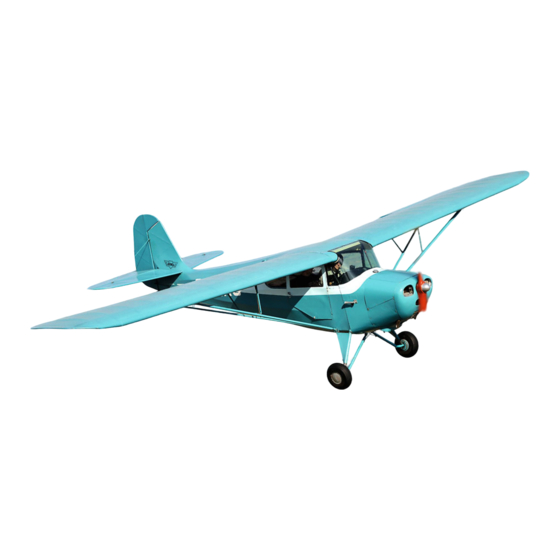
Advertisement
Quick Links
Pilot's Operating Handbook
This manual has been prepared to inform the pilot of systems and features
incorporated in the Aeronca Model 11AC aircraft. The enclosed operating
procedures and performance data are provided so that maximum utilization can
be obtained with the utmost safety, economy and serviceability.
This manual does NOT replace the FAA approved placards and operating limits
in a specific aircraft. If a difference exists between this manual and the FAA
approved placards / operating limitations, the FAA approved placards and
operating limitations shall be the authority.
This manual is provided to the Aeronca "Chief" Owner for Flight and Operating
procedures. It includes a copy of the aircraft Type Certificate as well as
specifications and performance data.
Aeronca -
Engine:
Continental
Type Certification No.
Cylinder Bore
Stroke
Displacement
Rated HP (sea level)
Maximum RPM
Recommended Cruise RPM 2150
Minimum Octane
Oil pressure - cruise
- Minimum
Oil Capacity
Max Oil Temp
(at 100 F outside temp)
11AC Chief
A-65-8
E-205
3.875
3.625
171 ci
65 hp
2300
73
30/40
10
4.5 qt
220
Advertisement

Summary of Contents for Aeronca Aeronca - 11AC Chief
- Page 1 4.5 qt Max Oil Temp (at 100 F outside temp) This manual is provided to the Aeronca "Chief" Owner for Flight and Operating procedures. It includes a copy of the aircraft Type Certificate as well as specifications and performance data.
-
Page 2: General Description
A large baggage compartment is located behind the seat to accommodate luggage and other items. The famous Aeronca Oleo Landing gear is incorporated in the Chief. This time- tested method of landing gear construction ensures sturdy yet smooth handling on rough fields. - Page 3 CABIN Plexiglas windows are used throughout, assuring a minimum of discoloration due to exposure. When cleaning, all grit and foreign particles should be flushed off with clean water. Final cleaning should be done with a soft cloth and any recommended type of Plexiglas cleaner. Never use dirty, oily rags to clean Plexiglas.
-
Page 4: Airplane Specifications
Airplane Specifications Airframe Length 20' 5" Height 6' 7" Height Level 8' 8" Wing Span Aspect Ratio 7.25 Wing Chord 60" Stabilizer Span 10' 2" Wheel Tread 72" Wheel Base 15' 10" Stabilizer Incidence -3.5 degrees Wing Dihedral +2 degrees Wing Incidence +1 degree Fin Offset... -
Page 5: Preflight Inspection
Fuel Consumption 4.4 Gal/Hr @ 2150 Cruise Range 270/420 miles Oil 4 Quarts (U.S.) Minimum Oil Consumption .75 Pint per Hr. 10 lbs. Idle (Min) Oil Pressure 30-40 Cruise (Green) 90 Min for Take-Off Oil Temperature 220 Max (Red Line) Propeller Limits Max 2300 RPM Tachometer... - Page 6 Brakes - CHECK condition, clips install, hub clean, cable tight Oleo undamaged, no leak, exposed strut similar on both gear Gear attach bolts secure no looseness 4. Fuselage (Right Side) Aux Fuel - CHECK quantity, color, cap secure, vents free (cap and belly vent) Fabric - CHECK condition Windows - CHECK condition, cleanliness...
- Page 7 Fuel quantity visual check, cap secure, vent clear Muffler pipes secure and tight McDowell Starter cable tight Cowling and Access Panel - CHECK condition, security Propeller and Spinner - CHECK condition, security Air Filter - CHECK condition. ENGINE PRE START 1.
-
Page 8: Before Taxi
CAUTION Do not over-prime or excessively pump the throttle (carburetor accelerator pump) due to the resulting fire hazard. The use of the fuel primer will vary with each engine and temperature condition. If the engine is warm, little or no prime is required. During cold weather conditions, 4 to 6 priming strokes may be required. - Page 9 12. Idle RPM 800 maximum 13. Controls free Take-Off - Normal 1. Controls - CHECK Free and Correct 2. Instruments - CHECK 3. Trim - SET for take-off 4. Main Fuel Valve - OPEN (IN) 5. Aux Fuel Valve - CLOSED 6.
- Page 10 Full stall (3 point) landings are recommended for soft or rough fields. Crosswind approaches can best be accomplished by using the wing down, top rudder method followed by either a full stall or wheel landing technique. Keep the lower wing into the wind after touchdown. Do not drop the tail until airspeed is well below flying speed.
- Page 11 8. Master switch ON 9. Primer locked 10. Attempt restart 11. Fly the airplane 12. Notify 121.5 of your location on the radio if turned on and available 13. When no Engine start is possible close fuel valve and throttle lock primer 14.
Need help?
Do you have a question about the Aeronca - 11AC Chief and is the answer not in the manual?
Questions and answers